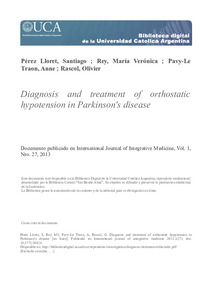Por favor, use este identificador para citar o enlazar este ítem:
https://repositorio.uca.edu.ar/handle/123456789/1640| Campo DC | Valor | Lengua/Idioma |
|---|---|---|
| dc.contributor.author | Pérez Lloret, Santiago | es |
| dc.contributor.author | Rey, Verónica | es |
| dc.contributor.author | Pavy-Le Traon, Anne | es |
| dc.contributor.author | Rascol, Olivier | es |
| dc.date.accessioned | 2019-05-02T14:01:14Z | - |
| dc.date.available | 2019-05-02T14:01:14Z | - |
| dc.date.issued | 2013 | - |
| dc.identifier.citation | Pérez Lloret, S., Rey M.V., Pavy-Le Traon, A., Rascol, O. Diagnosis and treatment of orthostatic hypotension in Parkinson's disease [en línea]. International Journal of Integrative Medicine. 2013, 1 (27). doi: 10.5772/56924. Disponible en: https://repositorio.uca.edu.ar/handle/123456789/1640 | es |
| dc.identifier.issn | 1848-8846 | - |
| dc.identifier.uri | https://repositorio.uca.edu.ar/handle/123456789/1640 | - |
| dc.description.abstract | Abstract: Orthostatic hypotension (OH) is a frequent comorbidity affecting between 23 and 38% of Parkinson’s disease (PD) patients. Several pieces of evidence suggest that OH is related to faster cognitive decline and more frequent falls, and has been also connected to increased mortality. OH can be arbitrarily defined as a drop of systolic and/or diastolic blood pressure of 20 or 10 mmHg or more in the first three minutes after passing from decubitus to an upright position. Till test appears to be the most reliable tool for assessing the orthostatic response. On the other hand, the standing test and evaluation of orthostatic symptoms should be regarded as screening tests. The key physiopathological aspect of OH is an altered baroreflex function resulting from cardiac and vascular sympathetic denervation. Nonetheless, OH can be aggravated by heat, alcohol consumption or by drug treatments, such as antihypertensives, dopamine agonists or amantadine. Treatment should begin with re‐considering drug treatments. After treatment is optimized, nonpharmacological measures may be employed. Drugs treatment should be reserved for patients in whom other strategies have failed. Midodrine and fludrocortisone are the most frequently used treatments, even though evidence about their efficacy and safety is weak. Midodrine has a shorter duration of action and thus avoidance of evening dosing may help keep nocturnal blood pressure dipping intact. Promising alternatives may include droxidopa and fipamezole | es |
| dc.format | application/pdf | es |
| dc.language | eng | es |
| dc.language.iso | eng | es |
| dc.publisher | InTech | es |
| dc.rights | Acceso Abierto | es |
| dc.rights.uri | https://creativecommons.org/licenses/by-nc-sa/4.0/ | es |
| dc.source | Journal of Integrative Medicine, Vol. 1, Nro. 27, 2013 | es |
| dc.subject | ENFERMEDADES NEUROGENERATIVAS | es |
| dc.subject | ENFERMEDAD DE PARKINSON | es |
| dc.subject | TRATAMIENTO | es |
| dc.subject | HIPOTENSION ORTOSTATICA | es |
| dc.title | Diagnosis and treatment of orthostatic hypotension in Parkinson's disease | es |
| dc.type | Artículo | es |
| dc.identifier.doi | 10.5772/56924 | - |
| uca.path | Facultad de Ciencias Médicas|Departamento de Docencia e Investigación | es |
| uca.disciplina | MEDICINA | es |
| uca.filename | /home/data-uca-generic/folder_generic/IIBiomedicas/diagnosis-treatment-orthostatic/metadata.xml | es |
| uca.issnrd | 1 | es |
| uca.affiliation | Fil: Pérez Lloret, Santiago. Pontificia Universidad Católica Argentina. Laboratorio de Farmacología Clínica y Epidemiología; Argentina | es |
| uca.affiliation | Fil: Pérez Lloret, Santiago. Universidad de Toulouse III. Hospital Universitario. Departamento de Investigación Clínica; Francia | es |
| uca.affiliation | Fil: Pérez Lloret, Santiago. Universidad de Toulouse III. Hospital Universitario. Departamento de Farmacología Clínica y Neurociencias; Francia | es |
| uca.affiliation | Fil: Pérez Lloret, Santiago. Institut national de la santé et de la recherche médicale; Francia | es |
| uca.affiliation | Fil: Rey, Verónica. Pontificia Universidad Católica Argentina. Laboratorio de Farmacología Clínica y Epidemiología; Argentina | es |
| uca.affiliation | Fil: Rey, Verónica. Universidad de Toulouse III. Hospital Universitario. Departamento de Investigación Clínica; Francia | es |
| uca.affiliation | Fil: Rey, Verónica. Universidad de Toulouse III. Hospital Universitario. Departamento de Farmacología Clínica y Neurociencias; Francia | es |
| uca.affiliation | Fil: Rey, Verónica. Institut national de la santé et de la recherche médicale; Francia | es |
| uca.affiliation | Fil: Pavy-Le Traon, Anne. Universidad de Toulouse III. Hospital Universitario. Departamento de Investigación Clínica; Francia | es |
| uca.affiliation | Fil: Pavy-Le Traon, Anne. Universidad de Toulouse III. Hospital Universitario. Departamento de Farmacología Clínica y Neurociencias; Francia | es |
| uca.affiliation | Fil: Pavy-Le Traon, Anne. Institut national de la santé et de la recherche médicale; Francia | es |
| uca.version | publishedVersion | es |
| item.fulltext | With Fulltext | - |
| item.grantfulltext | open | - |
| item.languageiso639-1 | en | - |
| crisitem.author.dept | Laboratorio de Neurobiología Molecular | - |
| crisitem.author.dept | Consejo Nacional de Investigaciones Científicas y Técnicas | - |
| crisitem.author.orcid | 0000-0001-9069-6512 | - |
| crisitem.author.parentorg | Instituto de Investigaciones Biomédicas - BIOMED | - |
| Aparece en las colecciones: | Artículos | |
Ficheros en este ítem:
| Fichero | Descripción | Tamaño | Formato | |
|---|---|---|---|---|
| diagnosis-treatment-orthostatic.pdf | 464,26 kB | Adobe PDF |  Visualizar/Abrir |
Visualizaciones de página(s)
167
comprobado en 30-abr-2024
Descarga(s)
205
comprobado en 30-abr-2024
Google ScholarTM
Ver en Google Scholar
Altmetric
Altmetric
Este ítem está sujeto a una Licencia Creative Commons

